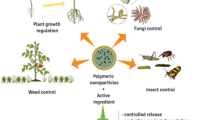Abstract
Using diverse technological approaches, many types of delivery devices have been used to supply plant nutrients at a controlled rate in the soil. One new approach is the use of hydrophilic polymers as carriers of plant nutrients. These polymers may be generally classified as 1) natural polymers derived from polysaccharides, 2) semi-synthetic polymers (primarily cellulose derivatives), and 3) synthetic polymers. By controlling the reaction conditions when forming the polymers, various degrees of cross-linking, anionic charge, and cationic charge can be added, thereby changing their effectiveness as fertilizer carriers.
When fertilizer-containing solutions are mixed with hydrophilic polymers to form a “gel” prior to application in the soil, the release of soluble nutrients can be substantially delayed compared with soluble fertilizer alone. The effectiveness of a specific controlled-release polymeric system is determined in part by its specific chemical and physical properties, its biodegradation rate, and the fertilizer source used. Addition of some polymers with nutrients has been shown to reduce N and K leaching from well-drained soils and to increase the plant recovery of added N, P, Fe, and Mn in some circumstances
Similar content being viewed by others
References
Azzam RAI (1980) Agricultural polymers: Polyacrylamide preparation, application, and prospects in soil conditioning. Commun Soil Sci Plant Anal 11: 767–834
Azzam RAI (1983) Polymeric conditioner gels for desert soils. Commun Soil Sci Plant Anal 14: 739–760
Bowman DC, Evans RY and Paul JL (1990) Fertilizer salts reduce hydration of polyacrylamide gels and affect physical properties of gel-amended container media. J Am Soc Hort Sci 115: 382–386
Dyson RW (1987) Specialty polymers. Blackie and Son Ltd., London
Flannery RL and Busscher WJ (1982) Use of synthetic polymer in potting soils to improve water holding capacity. Commun Soil Sci Plant Anal 13: 103–111
Foster WJ and Keever GJ (1990) Water absorption of hydrophilic polymers (hydrogels) reduced by media amendments. J Environ Hort 8: 113–114
Gray D (1981) Fluid drilling of vegetable seeds. Hortic Rev 3: 1–27
Henderson JC and Hensley DL (1985) Ammonium and nitrate retention by hydrophilic gel. Hort Sci 20: 667–668
Johnson MS (1984) Effect of soluble salts on water absorption by gel forming soil conditioners. J Sci Food Agric 35: 1063–1066
Johnson MS and Veltkamp CJ (1985) Structure and functioning of water-storing agricultural polyacrylamides. J Sci Food Agric 36: 789–793
Kazanskii KS and Dubrovskii SA (1992) Chemistry and physics of “agricultural” hydrogels. Adv Polymer Sci 104: 97–133
Kelen T (1983) Polymer degradation. Van Nostrand Reinhold Co Inc, New York. NY
Magalhaes JR, Wilcox GE, Rodriguez FC, Silva FLIM and Ferreira Rocha AN (1987) Plant growth and nutrient uptake in hydrophilic gel treated soil. Commun Soil Sci Plant Anal 18: 1469–1478
Martin CA, Ruter JM, Roberson RW and Sharp WP (1993) Element absorption and hydration potential of polyacrylamide gels. Commun Soil Sci Plant Anal 24: 539–548.
Mikkelsen RL (1990) Research on gel-type fertilizers. In: Havlin JL and Jacobsen JS (eds) Great Plains Soil Fertility Conf Proc 3: 78–81. Denver, CO
Mikkelsen RL (1994) Using hydrophilic polymers to enhance uptake of manganese fertilizers by soybeans. Fert Res (In review)
Mikkelsen RL, Behel AD Jr and Williams HM (1993) Addition of gel-forming hydrophilic polymers to nitrogen fertilizer solutions. Fert Res 36: 55–61
Mortvedt JJ, Mikkelsen RL and Behel AD Jr (1992a) Grain sorghum response to granular formulations of iron sources and hydrophilic polymers. J Plant Nutr 15: 1913–1926
Mortvedt JJ, Mikkelsen RL and Kelsoe JJ (1992b) Crop response to ferrous sulfate in banded gels of hydrophilic polymer. Soil Sci Soc Am J 56: 1319–1324
Otey FH, Trimnell D, Westhoff RP and Shasha BS (1984) Starch matrix for controlled release of urea fertilizer. J Agric Food Chem 32: 1095–1098
Ratner BD and Hoffman AS (1976) Synthetic hydrogels for biomedical applications. In: Andrade JD (ed) Hydrogels for medical and related applications, pp 1–36. Am Chem Soc, Washington DC
Salem N, Vigna Guidi G, Pini R and Khater A (1991 ) Quality of irrigation waters and water uptake of a polyacrylamide hydrogel. Agrochimica 35: 149–160
Shalaby SW, McCormick CL and Butler GB (1991) Water-soluble polymers: Synthesis, solution properties, and applications. ACS Symp 467 Am Chem Soc, Washington DC
Shaviv A and Mikkelsen RL (1993) Slow-release fertilizers to increase efficiency of nutrient use and minimize environmental degradation- A review. Fert Res 35: 1–12
Smith JD and Harrison HC (1991) Evaluation of polymers for controlled-release properties when incorporated with nitrogen fertilizer solutions. Commun Soil Sci Plant Anal 22: 559–573
Terry RE and Nelson SD (1986) Effects of polyacrylamide and irrigation method on soil physical properties. Soil Sci 141: 317–320
Author information
Authors and Affiliations
Rights and permissions
About this article
Cite this article
Mikkelsen, R.L. Using hydrophilic polymers to control nutrient release. Fertilizer Research 38, 53–59 (1994). https://doi.org/10.1007/BF00750062
Received:
Accepted:
Issue Date:
DOI: https://doi.org/10.1007/BF00750062




